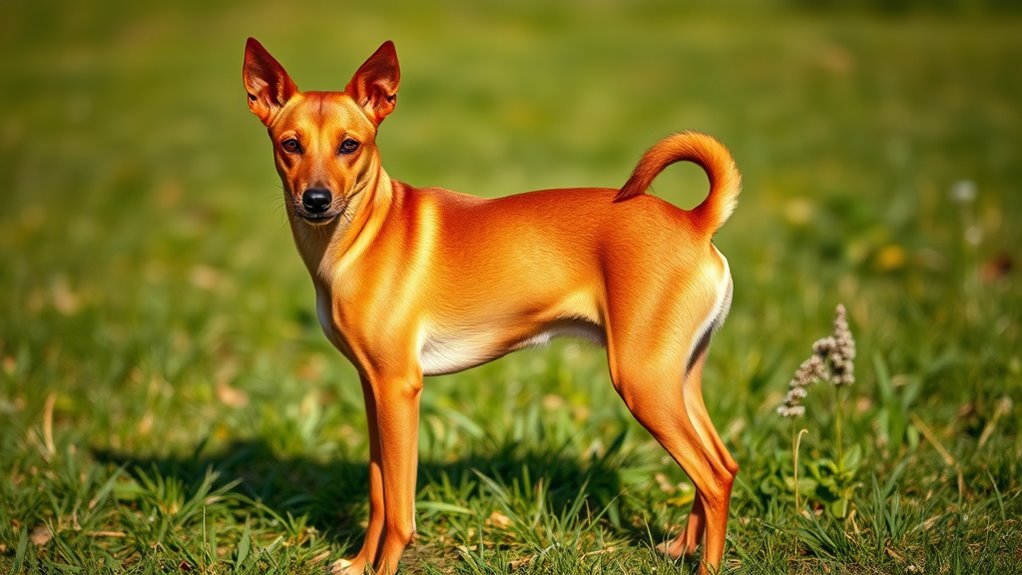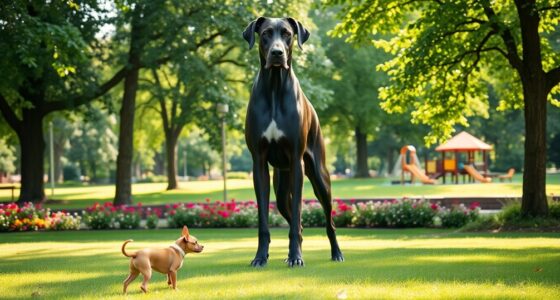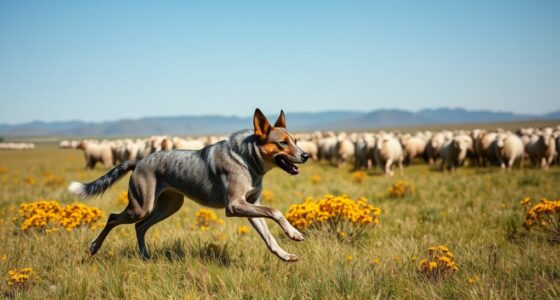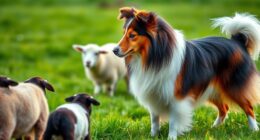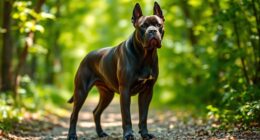The Basenji is a stunning, energetic breed known for its minimal barking and unique vocalizations like yodels and high-pitched yelps. Originating from West Africa, these dogs have a sleek, muscular build, expressive eyes, and a short coat that’s easy to maintain. They’re intelligent, curious, and independent, making training a fun challenge. To discover more about their health, personality, and care, explore how you can make a Basenji a perfect companion.
Key Takeaways
- The Basenji is known as the “barkless dog” due to its unique vocalizations like yodels and high-pitched sounds instead of barking.
- Its vocalizations include melodic yelps, whines, and yodels, which communicate emotions effectively.
- Despite being called barkless, the breed can make various sounds, but it rarely produces typical dog barks.
- The breed’s quiet nature makes it suitable for environments where barking is undesirable.
- Its vocal behavior is part of its distinctive personality, stemming from its ancient origins and hunting instincts.
The Unique Vocalizations of the Basenji
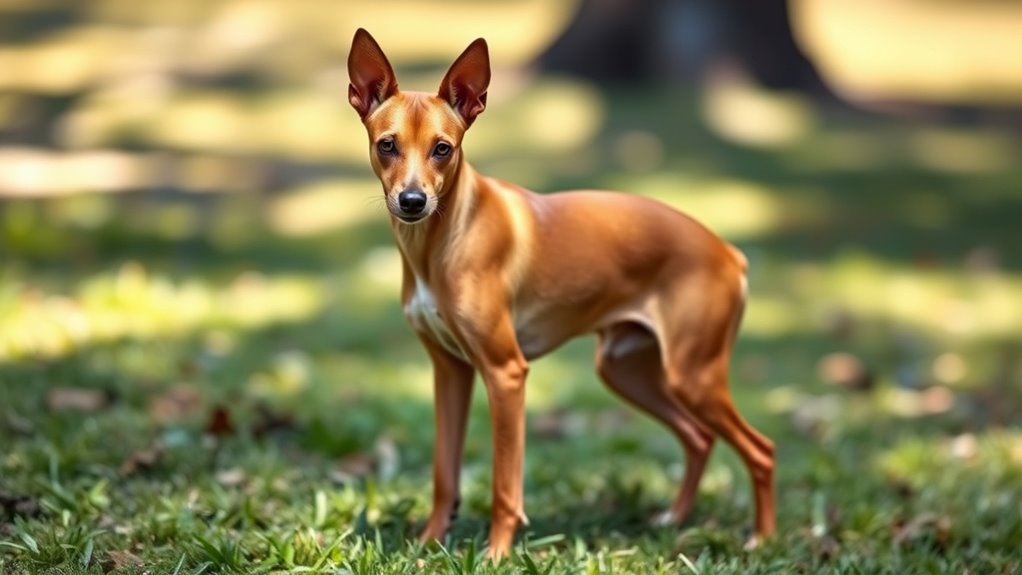
The Basenji’s vocalizations are unlike those of most other dog breeds. Instead of barking, you’ll notice they produce a range of unique sounds that reflect their distinct vocal communication style. These dogs often yodel, whine, or produce a high-pitched, melodic yelp that can be surprising if you’re expecting typical barks. Their vocalizations serve to communicate different emotions, from alertness to excitement. Because of their unique sounds, you might find yourself listening intently, trying to interpret their subtle cues. This breed’s vocal communication is part of what makes them so intriguing and different. Additionally, understanding their vocal communication can help you better connect with and care for your Basenji. Their distinctive sounds are often mistaken for other vocal behaviors, but recognizing the nuances can enhance your bond. Recognizing the subtle cues in their vocalizations can provide insight into their mood and needs, fostering a stronger relationship. Being aware of their performance of vocalizations can help prevent misunderstandings and improve your overall companionship. Developing an awareness of vocal cues can further deepen your understanding of their emotional state and strengthen your bond.
Origins and History of the Breed
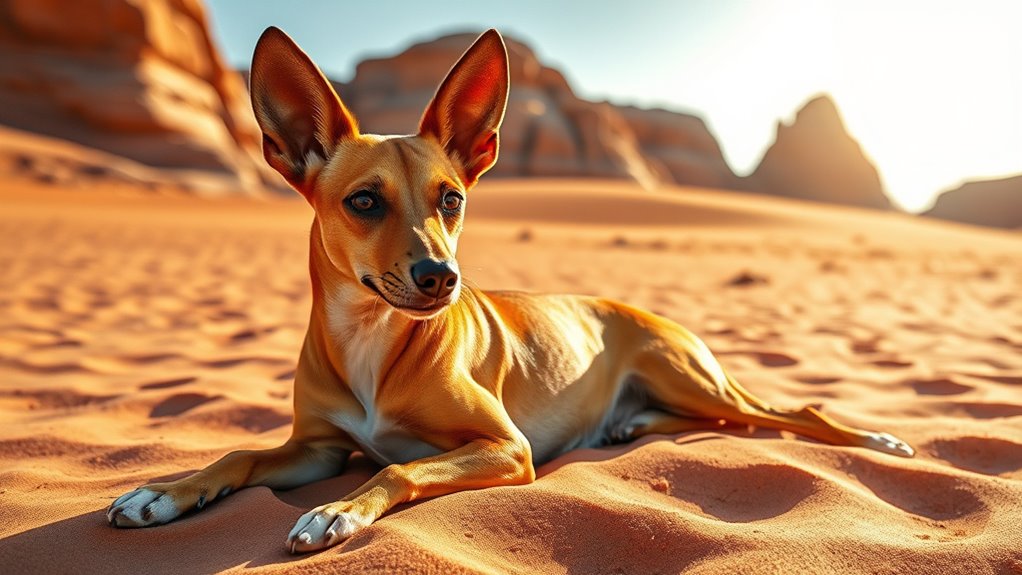
Originating in West Africa, the Basenji has a long history as a hunting and tracking dog valued for its agility and keen senses. Its roots trace back thousands of years, with ancient Egyptian symbolism depicting similar dogs as symbols of status and fertility. The breed’s recognition history is fascinating; Europeans first encountered Basenjis in the 19th century, and they gained popularity among explorers and collectors. Despite their ancient origins, formal breed standards weren’t established until the 20th century. Understanding the biodiversity of ancient dog breeds highlights their unique adaptations and cultural significance, which contributes to their distinctive characteristics and enduring appeal in modern times. Additionally, recent technological advancements have helped preserve and study the genetic diversity of such traditional breeds, ensuring their continued existence for future generations and fostering a deeper appreciation for their cultural heritage.
Physical Characteristics and Appearance
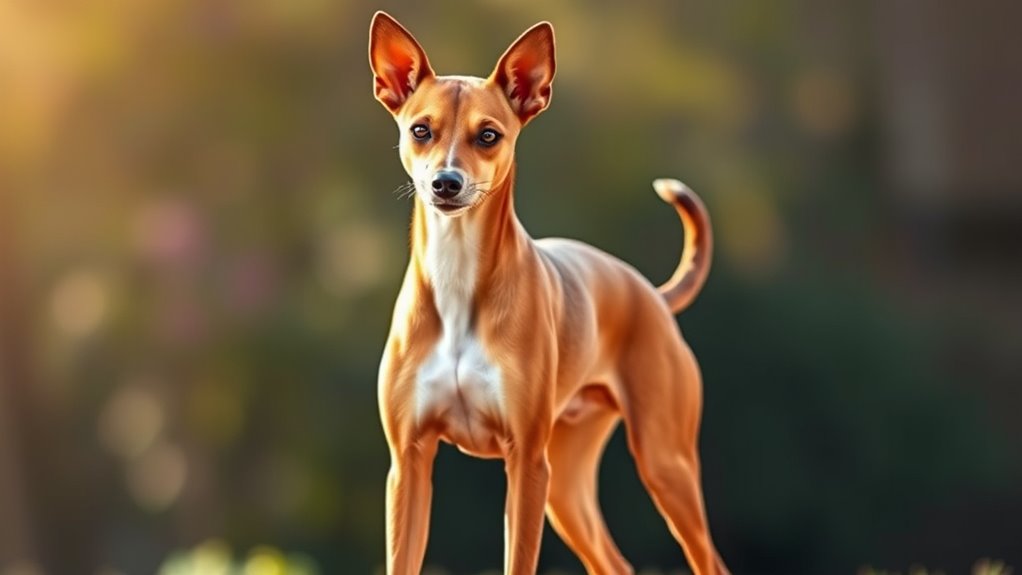
You’ll notice that Basenjis have a sleek, muscular build that gives them agility and grace. Their distinctive facial features, including a wrinkled forehead and expressive eyes, set them apart. Plus, their short, fine coat keeps them cool and easy to maintain. Their physical traits contribute to their alert and lively demeanor. Additionally, their tail is often carried high with a slight curl, emphasizing their unique appearance. This breed’s overall body structure enhances their natural agility and speed.
Sleek, Muscular Build
With their lean, athletic frame, Basenji dogs exemplify agility and strength. Their sleek, muscular build helps them excel in running and jumping, showcasing their natural agility. To maintain this physique, you need to meet their dietary needs with high-quality, balanced nutrition that supports muscle development. Proper puppy socialization is vital early on, as it encourages confident, well-rounded behavior that complements their active build. Their compact body is designed for speed and endurance, making them excellent at chasing and exploring. You’ll notice their smooth coat adds to their streamlined appearance. A well-maintained physique requires regular exercise and attention to diet. Engaging in remote training sessions can help reinforce commands and foster good behavior in active dogs like the Basenji, especially when outdoor activities are limited. Maintaining consistent grooming ensures their coat remains healthy and shiny, further supporting their athletic appearance. Incorporating exercise routines that challenge their agility will help keep them in peak condition. Additionally, understanding their unique behavioral traits can help tailor training and care routines to suit their energetic nature. Ensuring a variety of training techniques can also enhance their mental stimulation and overall well-being. This combination ensures your Basenji remains healthy, energetic, and proud of their athletic, muscular appearance.
Distinctive Facial Features
The Basenji’s striking facial features set it apart from other breeds, giving it a keen and alert expression. Its facial structure is refined, with a graceful skull and well-defined cheekbones that emphasize alertness. The eye shape plays a vital role, characterized by almond-shaped, expressive eyes that convey intelligence and curiosity. You’ll notice the pointed ears, which stand erect and add to its attentive appearance. The narrow muzzle and slightly arched neck create a sleek profile. These features combine to produce a face that’s both alert and refined, reflecting the breed’s alertness and independence. Regular checks on facial features can help identify early signs of health issues, ensuring the breed remains vibrant and alert. Additionally, the breed’s distinctive physical characteristics are crucial for understanding its health and behavior. Proper maintenance of facial hygiene can also prevent infections and skin conditions that might otherwise affect its expressive features. Maintaining muscle tone around the face and neck can further support its overall health and alertness. Understanding the material and meaning behind these features helps in appreciating how physical traits are shaped by both genetics and environment.
Short, Fine Coat
The Basenji’s coat is particularly short and fine, giving it a sleek, smooth appearance. Its coat requires minimal maintenance, making grooming straightforward. You’ll find that shedding patterns are light and manageable, often limited to seasonal changes. Regular brushing once a week helps remove loose hairs and keeps the coat looking healthy. Because the coat is so fine, it’s less prone to matting or dirt buildup, but staying consistent with coat maintenance guarantees it stays clean and shiny. This breed doesn’t shed excessively, which is ideal if you’re looking for a low-shedding dog. Overall, the Basenji’s short, fine coat contributes to its elegant look and easy care routine, fitting well into active households that prefer a low-maintenance, attractive companion.
Temperament and Personality Traits
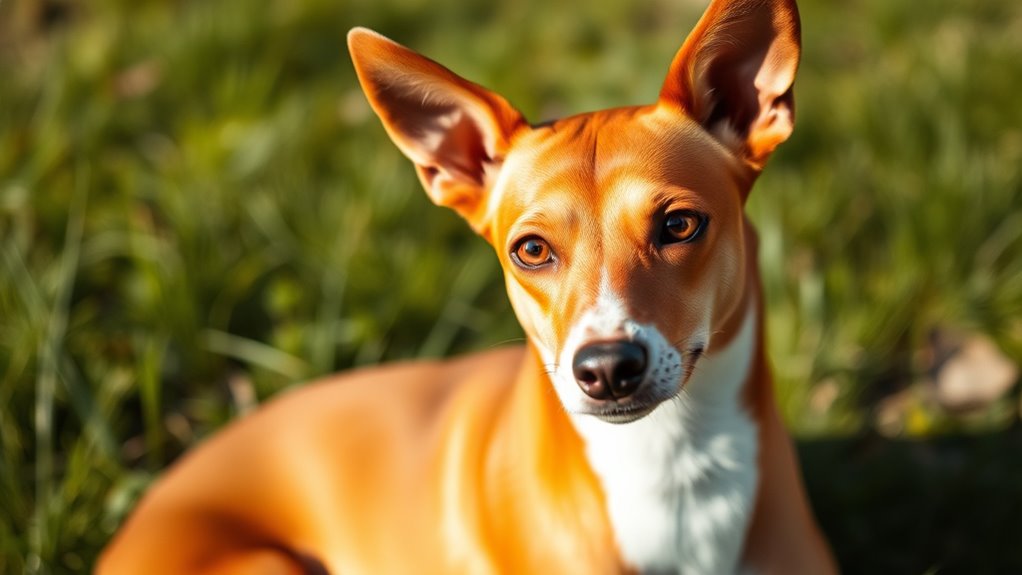
Although they may seem reserved at first, Basenji dogs have a lively and intelligent personality that makes them unique among breeds. They tend to be independent, often preferring to explore on their own, which influences their social behavior. You’ll find that they’re alert and curious, making them excellent watchdogs. However, their independence means they might not always seek constant attention or cuddles. They’re known for being clever and quick learners, but sometimes stubborn, so patience is key. Their cheating nature can sometimes lead to behavioral challenges if not properly engaged. Understanding their sound design can help in training and socialization, as their vocalizations and alertness require appropriate management. Additionally, their breed characteristics often include a strong hunting instinct, which can impact their behavior around small animals.
Exercise and Activity Needs
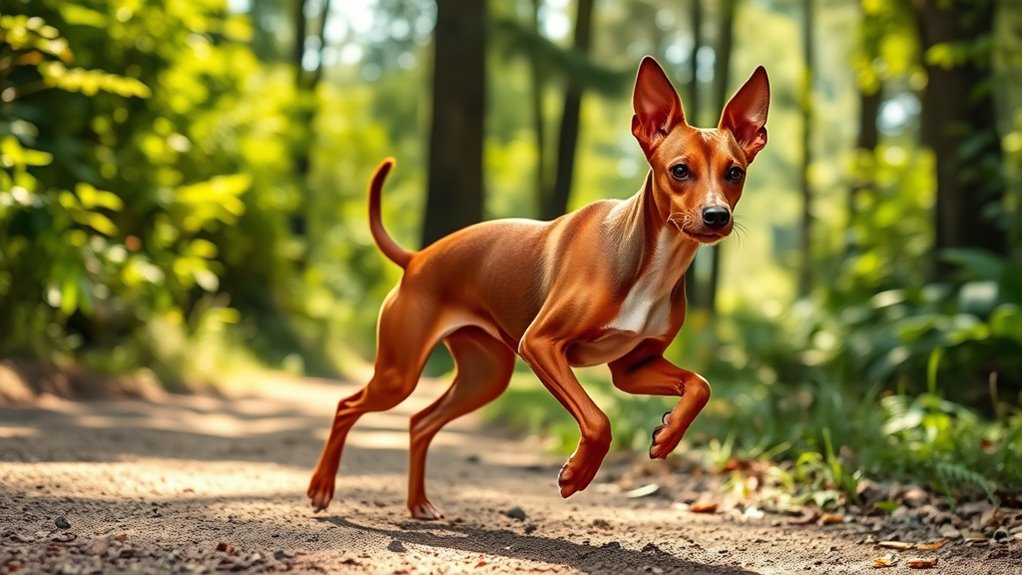
To keep a Basenji happy and healthy, providing them with regular exercise is a must. These energetic dogs thrive on engaging playtime activities that challenge their agility and intelligence. Incorporate daily exercise routines like brisk walks, runs, or off-leash play in a secure area, ensuring they burn off excess energy. Basenjis are known for their stamina and need consistent activity to prevent boredom and destructive behaviors. Mix up their playtime with fetch, agility training, or puzzle toys to stimulate both their body and mind. Remember, a tired Basenji is a well-behaved Basenji. They may not demand constant activity, but they do require structured, daily exercise to stay content and healthy. Engage with them regularly to keep their spirits high.
Grooming and Care Requirements
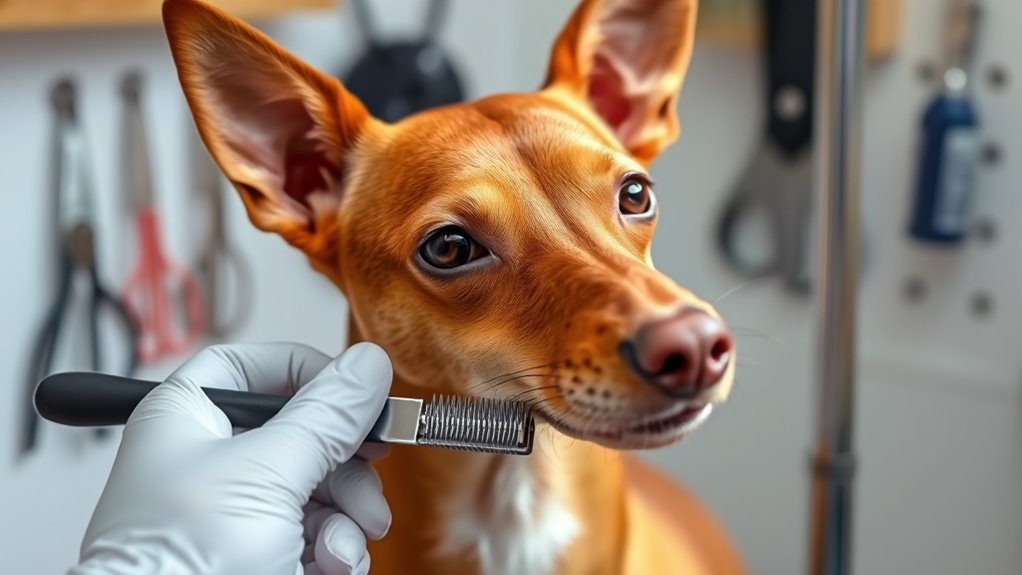
Grooming and care requirements for a Basenji are straightforward but essential for keeping your dog healthy and looking its best. Regular grooming helps maintain a shiny coat and prevents skin issues. You should groom your Basenji about once a week to remove loose hair and dirt. Coat maintenance is simple, thanks to their short, fine fur that sheds minimally.
Regular weekly grooming keeps your Basenji healthy, shiny, and comfortable with minimal shedding.
- Brush weekly to reduce shedding and distribute natural oils
- Bathe as needed, usually every few months
- Check ears, trim nails, and clean teeth regularly
Sticking to these grooming routines ensures your Basenji stays comfortable and healthy. Consistent care not only keeps their coat in top shape but also helps you spot any health concerns early.
Training Challenges and Tips

While maintaining your Basenji’s coat is straightforward, training can present unique challenges due to their independent nature. They tend to be aloof and selective, making early puppy socialization essential. Expose your puppy to different people, dogs, and environments to build confidence and reduce timidity. Consistent crate training techniques are crucial; use the crate as a safe space rather than a punishment, encouraging your Basenji to see it as a comfortable retreat. Be patient and firm, establishing routines that promote obedience and trust. Keep training sessions short but frequent, focusing on positive reinforcement. Remember, your Basenji’s intelligence means they learn quickly but can also become bored or stubborn. Staying consistent and engaging will help you overcome training challenges and develop a well-behaved companion.
Health Considerations and Lifespan
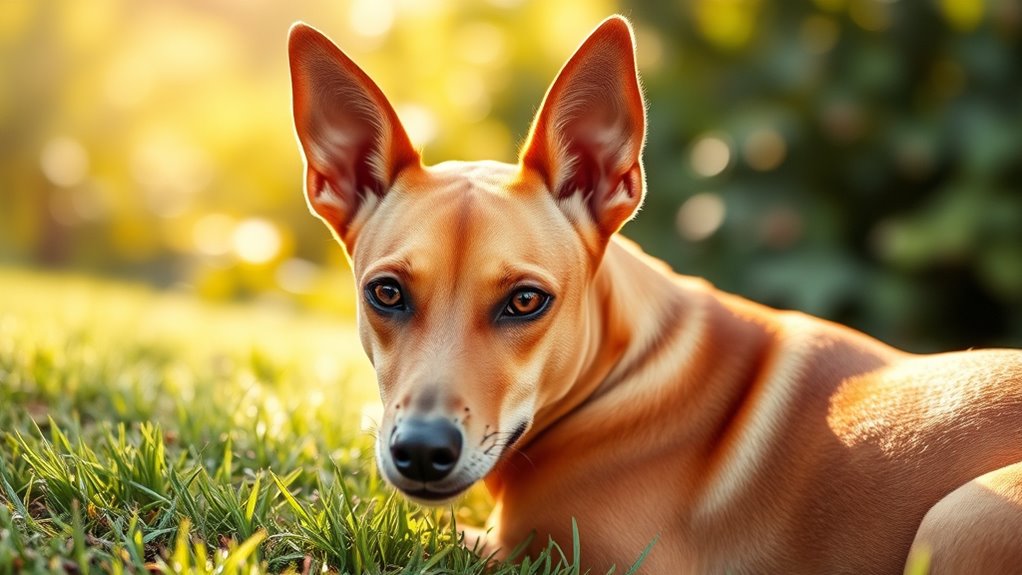
Are you aware of the specific health considerations that come with owning a Basenji? Their lifespan typically ranges from 12 to 16 years, but certain health issues may arise. You should pay close attention to:
- Diet considerations, ensuring a balanced, high-quality diet to prevent obesity and support joint health.
- Veterinary health, including regular check-ups to catch potential conditions like hip dysplasia or progressive retinal atrophy early.
- Unique traits, such as their sensitive skin, which can require specific care and monitoring for allergies or infections.
Being proactive helps maintain your dog’s vitality and longevity. Proper diet and routine veterinary visits are essential for preventing common health problems. Staying informed and attentive ensures your Basenji stays healthy and happy throughout its life.
Frequently Asked Questions
Do Basenjis Get Along Well With Other Pets?
When considering if a Basenji gets along well with other pets, you should focus on their social compatibility. They can be friendly and curious, but early pet introduction is key. You need to introduce them gradually and monitor their interactions. Some Basenjis may be more territorial, so patience and positive reinforcement help. With proper socialization, many Basenjis can coexist peacefully with other pets in your home.
What Is the Average Cost to Adopt a Basenji?
Getting a dog is no small feat, and the cost can vary widely. On average, adoption fees for a Basenji from a breed rescue typically range from $150 to $300. These fees often cover vaccinations, spaying/neutering, and microchipping. Remember, adopting from a breed rescue supports a good cause and helps you find a dog that fits your lifestyle. It’s a win-win situation that’s worth every penny!
Can Basenjis Live Comfortably in Apartments?
You can definitely keep a basenji in an apartment if you provide indoor enrichment and address their noise sensitivity. They thrive with mental stimulation like puzzle toys and regular exercise. Keep in mind, their alertness might lead to noise if they’re bored or anxious, so training and consistency are key. With proper care, your basenji can be a happy, well-adjusted indoor companion, even in smaller living spaces.
Are Basenjis Suitable for First-Time Dog Owners?
Thinking about getting a dog? Well, you’re signing up for a lively adventure! Basenjis can be great, but they’re not the easiest for first-time owners. They have training challenges and strong socialization needs, like a puzzle waiting to be solved. If you’re ready to put in effort and learn about their unique personality, you might find a loyal companion. Otherwise, consider a breed that’s a bit more beginner-friendly.
How Often Should I Take My Basenji to the Vet?
You should take your dog to the vet at least once a year for a check-up. During this visit, the vet will review the vaccination schedule and perform health screening to catch any issues early. Regular visits help keep your dog healthy and up-to-date on necessary vaccines. If your Basenji shows signs of illness or needs special care, more frequent vet trips might be needed.
Conclusion
You might think the basenji’s quiet nature is just a coincidence, but it’s rooted in its ancient origins. This breed’s unique vocalizations, like yodels, set it apart from other dogs. With proper care, training, and understanding of its history, you can enjoy a loyal, energetic companion. So, next time you hear a strange yodel, remember—you’re hearing a piece of history in every barkless bark.

